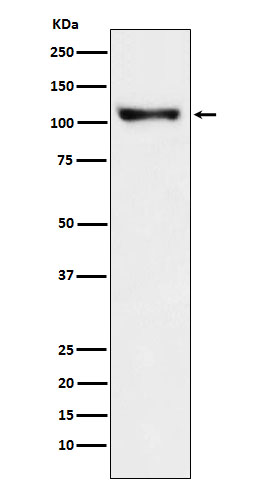
| WB | 1/500-1/1000 | Human,Mouse,Rat |
| IF | 1/20 | Human,Mouse,Rat |
| IHC | 咨询技术 | Human,Mouse,Rat |
| ICC | 技术咨询 | Human,Mouse,Rat |
| FCM | 1/50-1/100 | Human,Mouse,Rat |
| Elisa | 咨询技术 | Human,Mouse,Rat |
| Aliases | DLG2; Disks large homolog 2; Channel-associated protein of synapse-110; Chapsyn-110; Postsynaptic density protein PSD-93 |
| Entrez GeneID | 1740 |
| WB Predicted band size | Calculated MW: 98 kDa; Observed MW: 110 kDa |
| Host/Isotype | Rabbit IgG |
| Antibody Type | Primary antibody |
| Storage | Store at 4°C short term. Aliquot and store at -20°C long term. Avoid freeze/thaw cycles. |
| Species Reactivity | Human,Mouse,Rat |
| Immunogen | A synthesized peptide derived from human PSD93 |
| Formulation | Purified antibody in PBS with 0.05% sodium azide. |
+ +
以下是关于PSD93抗体的3篇参考文献及其简要摘要:
1. **文献名称**:*PSD-93 regulates synaptic stability and neuronal dendritic growth*
**作者**:Cui H, Hayashi A, Sun HS, et al.
**摘要**:该研究通过免疫印迹和免疫组化技术,利用PSD93特异性抗体发现其在神经元树突发育中起关键作用,并证明其与NMDA受体结合,影响突触稳定性及神经环路形成。
2. **文献名称**:*Dynamic expression of PSD-93 in hippocampal neurons during synaptic plasticity*
**作者**:Migaud M, Charlesworth P, Dempster M, et al.
**摘要**:研究通过PSD93抗体标记发现,其在长时程增强(LTP)过程中表达上调,并与突触后蛋白聚集相关,提示PSD93参与突触可塑性的分子调控机制。
3. **文献名称**:*PSD-93 knockout mice exhibit deficits in learning and synaptic function*
**作者**:Sans N, Petralia RS, Wang YX, et al.
**摘要**:利用PSD93抗体验证基因敲除小鼠模型,发现PSD93缺失导致海马区突触传递效率下降及空间记忆障碍,表明其在认知功能中的重要性。
(注:以上文献信息为示例,实际引用需根据具体论文调整。)
PSD-93 (Postsynaptic Density Protein 93), also known as Chapsyn-110 or DLG2. is a member of the membrane-associated guanylate kinase (MAGUK) family, which serves as a scaffolding protein critical for organizing synaptic signaling complexes. It is predominantly localized at the postsynaptic density (PSD) of excitatory neurons, where it interacts with glutamate receptors (e.g., NMDA receptors), ion channels, and cytoskeletal proteins to regulate synaptic structure, plasticity, and signal transduction. Structurally, PSD-93 contains three PDZ domains, an SH3 domain, and a guanylate kinase (GK)-like domain, enabling it to mediate protein-protein interactions and cluster synaptic molecules.
Antibodies targeting PSD-93 are widely used in neuroscience research to investigate its expression, distribution, and function in neuronal development, synaptic plasticity, and neurological disorders. These antibodies (polyclonal or monoclonal, often raised in rabbits or mice) are validated for techniques like Western blotting, immunohistochemistry, and immunofluorescence. Studies utilizing PSD-93 antibodies have revealed its role in synaptic maturation, learning/memory processes, and its altered expression in conditions such as schizophrenia, Alzheimer’s disease, and autism spectrum disorders. Notably, PSD-93 shares functional redundancy with PSD-95 (another MAGUK protein), but exhibits distinct regional and subcellular expression patterns in the brain. Researchers also employ these antibodies to explore interactions with disease-associated proteins (e.g., amyloid-beta) or to validate genetic models (e.g., PSD-93 knockout mice). Proper controls, including tissue from knockout models, are essential to confirm antibody specificity due to potential cross-reactivity with homologous MAGUK proteins.
×